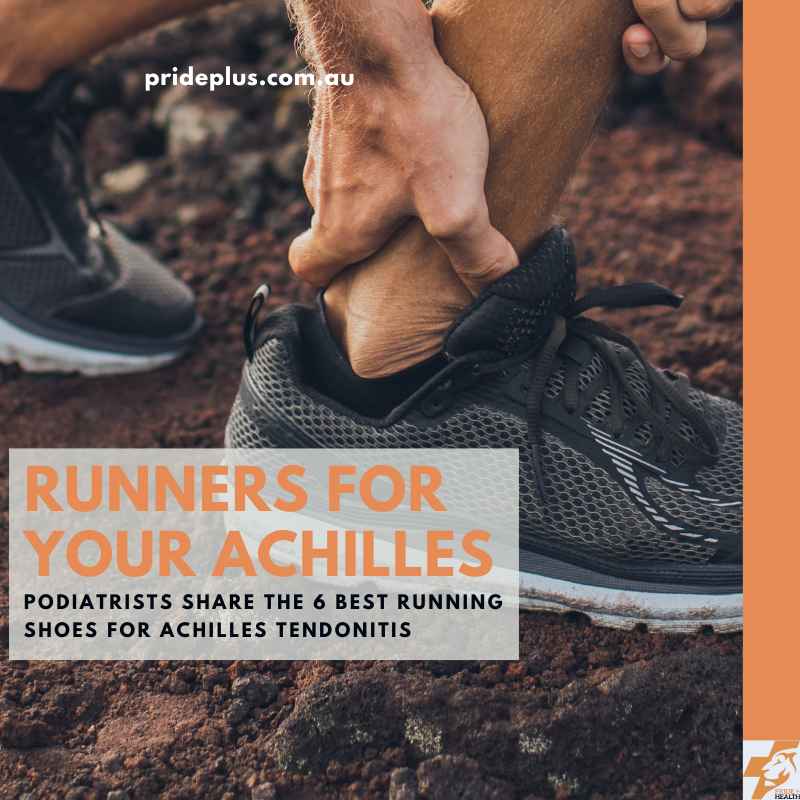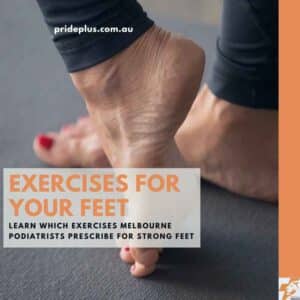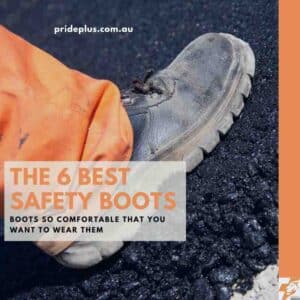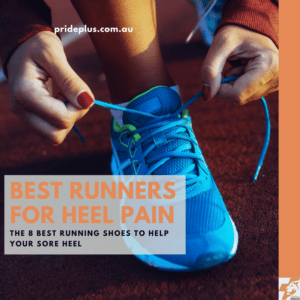Updated in April 2024, this is the 5 best running shoes for achilles tendonitis as chosen by our keen local runners who make up our expert podiatry team. Previously there were 6 shoes on the list, but due to changes made by Saucony we’re down to 5.
Now this list of shoes is something that we’ve put a lot of sweat and tears into. A couple of our podiatry team including yours truly developed Achilles tendonitis and put these shoes (and a bunch that didn’t cut it) to the test.
Unfortunately, this list of shoes wasn’t available to us when we first started getting the achilles tendon stiffness that is the first warning sign that your achilles is becoming overworked and on the way to becoming sore. If it was, well, just maybe we would have been able to get on top of our injury before it became chronic and needed more than just a pair of running shoes to help.
So, if you’re early on in your achilles tendonitis injury rehab, a pair of shoes from this list could be just the ticket to sorting you out. Or, if you’re a little further down the path you can get your shoes sorted and book your assessment and treatment with your podiatry or physio team. Treatments include exercise-based therapies as well as shockwave therapy.
The 5 Best Running Shoes for Achilles Tendonitis
Stats and Info: Why these are the best shoes for achilles tendonitis
Alright, let’s do a quick recap so we’re on the same page with a few key terms.
Firstly, achilles tendonitis is an injury that’s also known as achilles tendinopathy or achilles tendinosis. Essentially, your achilles tendon is being overworked and is becoming stiff and sore at the back of your heel.
Not to be confused with plantar fasciitis or achilles para-tenosynovitis which are two similar injuries that happen around the heel, achilles tendonitis is a real pain in the foot.
Usually, it’s first thing in the morning or at the end of a long run when you feel the stiffness and pain the most. The injury itself is all about capacity and exceeding your tendons. Think of a water glass. Every time you load up your tendon you put a bit of water into the glass, overnight, you empty the glass and start again in the morning.
With achilles pain from tendonitis, your water glass gets filled up, and not just one day, but every day for a long period. You have a couple of options, get a bigger water glass (which happens with exercise, shockwave therapy and training) or pour less water into the glass. Wearing the right shoes is a way where you get another side glass, your shoes, which can hold some of that water so less is going into your achilles cup.
Make sense?
Kind of?
Well here are the two most important features that the best shoes for achilles tendonitis all have.
- A high drop or offset.
- This is where the foam under your heel is higher than the foam under your toes.
- Laterally stable sole.
- This is key, the sole under the outside of your foot needs to be stable and firm enough so that it doesn’t compress and twist your achilles during the high loading times when you are pushing off through your toes.
Brooks Ghost 16
The Brooks Ghost 16 is one of the more popular shoes with podiatrists because it just about does the lot.
A 12mm drop weighing 296g (for the Men’s size 9) is the perfect starting point for tight and sore achilles tendons. Then, Brooks leaves us swooning by offering 4 different widths to the Ghost 15 so you can get very high-arched and narrow feet or a low-arched and wide foot into a pair comfortably.
Mizuno Wave Rider 27
The Wave Rider 27 is a great update to what has been a favourite long-run shoe of mine for many years.
To help reduce the stress and strain on your achilles tendon it has a whopping 12mm heel-to-toe drop (offset) and is nice and stable laterally to reduce twist and compression. At 280g (for a Men’s size 9) they’re on the lighter side for a full-thickness and plush cushioned running shoe.
You can get a pair of Wave Riders in 2 different widths for both Men and Women’s sizes as well as a Gore-Tex lined option for trail or winter running.
Long-term Mizuno wearers will have noticed how in recent years more colours are being brought into Australia. Right now you can get the standard Rider in over 15 different colour combinations.
For normal to high-arched runners with achilles tendonitis, this Wave Rider is a very good choice for your feet.
Asics Nimbus 26
The latest Asics Nimbus, the 26 makes it onto this list despite the fact it’s only operating with an 8mm drop.
How you ask?
The latest Asics Nimbus 26 has added extra cushioning foam under the midfoot which reduces the drop, and you’d be right in thinking that’s bad news for your achilles tendonitis. But the extra foam they’ve added makes this shoe even more laterally stable. They’ve improved how it reduces the worst kind of force (compression) on your tendon.
So, if you have a normal to higher arch the Asics Nimbus is a great shoe for your achilles tendonitis. Heaps of colours, fit options, plush cushioning and a decent weight of 300g for a Men’s size 9.
Nike Pegasus 40
Nike is up to model number 40 of the Pegasus at the time of writing.
There are not many models of running shoes that last that long. Over the years Peg’s have developed a cult-like following from runners who love the consistent feel that they get in each new pair of Pegasus’ they lace up on their feet.
For those of us with achilles tendonitis, Nike is looking out for us with a 10mm heel-to-toe drop and reducing the weight of them in recent times down to 261g for a Men’s size 9.
Due to the fit of the upper of the Pegasus, if you have a very high arch or very low arch it might be a bit tricky to lace them up comfortably every time. For normal-shaped feet (and as a podiatrist, we don’t see too many of you), the Pegasus will be a very comfortable and snug fit and feel in the upper.
New Balance 880v14
I really, really like this shoe from New Balance.
The 880 is one of the best-looking shoes that New Balance has made in years. Not only do they come in a variety of colours and widths they have a Gore-Tex option for trail running or walking through wet grass in the mornings.
But it’s not just about the looks, is it?
The 880 has a 10mm heel-to-toe drop and weighs 261g (for a Men’s size 9). Add in that you can find multiple widths of this shoe and you’ve got a great shoe for achilles tendonitis if you have a normal to higher arched foot.
Before you go…
If you’ve made it this far you’re already on the way to treating your achilles tendonitis. Why not learn a little bit more about your injury and other treatments that can help like shockwave for achilles tendonitis or how to reduce achilles pain?
FAQ about the best running shoes for achilles tendonitis
If you have a clear, structured plan from your physiotherapist or podiatrist for your running volume then you can often still run when you have achilles tendonitis.
But it’s not without risk.
Your achilles tendonitis pain is a signal that you’re overloading your tendon and more recovery and capacity is needed. But running gives us so much more than just tendon loads. For me, running is my happy place, it’s the time when my mind goes to relax, and reset and I just feel great.
Not running, or not running for a long period will end up leaving me with plenty of other problems that can be just as bad, or worse, than my achilles tendonitis.
This leads us nicely to the next question.
If you keep running with your achilles tendonitis without a clear plan in place, you run the risk of your tendon becoming chronically and permanently injured.
This sounds scary, and, some parts of it are.
If you consistently overload your achilles tendon then instead of a nice stretchy and elastic tendon that will spring you forward every time you run, you get something very different.
Chronically injured achilles tendons are very thick, inelastic and more readily get sore again in the future.
When shopping for running shoes when you have achilles tendonitis you need to make sure that your new shoe is a fantastic fit for your foot type. Nothing too narrow, too short, too wide or too deep.
Your new running shoes will have plenty of cushioning and ideally be supportive where you need them.
They’ll have a higher drop, where the heel cushioning is thicker than the ball of your foot. The heel counter won’t pinch or irritate your tendon attachment at the achilles insertion onto the calcaneus too.
Oh, and they’ll look good.
You have to look at the goods to feel the goods when you’re running and getting back from your achilles tendonitis.
We often get asked if we can change the way we walk or run to treat achilles tendonitis.
The short answer is yes, the long answer is yes and it’s difficult to do.
Taking shorter strides when you run increases the number of steps you take (this is often called cadence). You might think this is bad, as you need to take more steps to cover the same distance which means more times your achilles has to work hard.
But, there is some research to point out that more steps, more often is better for achilles tendonitis as it avoids some of the big strains on the tendon.
The easiest way to implement a form change is to try to run at 120 bpm. Pick a playlist with up-tempo tunes or set a metronome on your phone and aim to get your cadence up. If you were like me (I was a participant in this research out of La Trobe University) it will feel very strange. But maybe your tendon will like it?
You can prescribe a custom foot orthotic to decrease the peak loading on the achilles tendon.
When you raise your heel or reduce it from twisting in or out when you walk and run you can reduce the peak tensile and compressive forces that act on the achilles. These changes might be the difference between the 11/10 overload and the 7/10 perfect load your tendon needs to stay healthy and happy.
About the Author

Melbourne podiatrist, keen runner and La Trobe University educator Tim Mulholland wants you to get back to the running you love. His personal and professional battles with achilles tendonitis have ignited his mission to help sore tendons feel better again.




